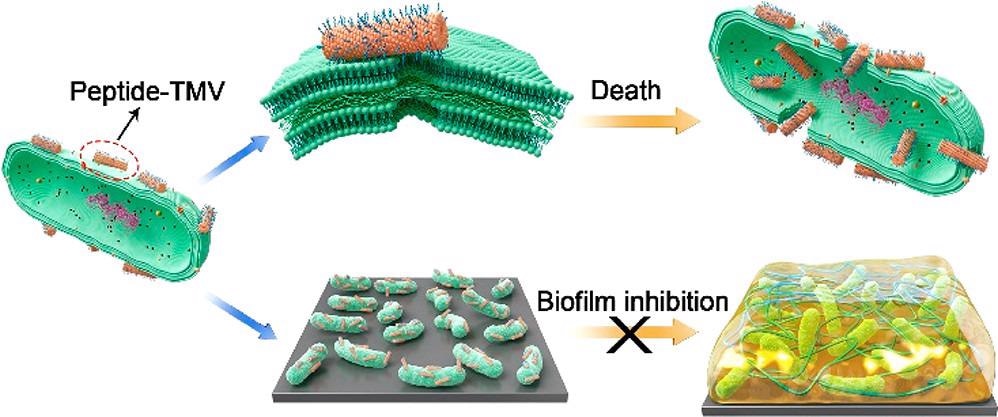Mar 31 2021
Researchers from China have recently leveraged a new approach to improve the activity of peptides against Gram-negative bacteria efficiently through the conjugation of the peptides onto a rod-like virus.
 Schematic Illustration of the Peptide-TMV inducing Bacteria‘s Death and Inhibiting Biofilm Formation. Image Credit: Niu et al.
Schematic Illustration of the Peptide-TMV inducing Bacteria‘s Death and Inhibiting Biofilm Formation. Image Credit: Niu et al.
Published online in the Nano Letters journal, the study was performed by Prof. Zhongwei Niu and Associate Prof. Ye Tian from the Technical Institute of Physics and Chemistry (TIPC) of the Chinese Academy of Sciences (CAS).
Problems caused by gram-negative bacteria and their infection have been threatening global health. Resistance to antibiotics is also a critical worldwide issue.
Consequently, antimicrobial peptides that cause very little antibiotic resistance are considered the most potential alternatives to antibiotics.
But when compared to antibiotics, the minimum inhibitory concentration and efficiencies of current peptides are lower. The clinical uses of peptides are also limited.
As part of this study, the researchers 'decorated' the peptides by conjugating them onto one-dimensional rod-like tobacco mosaic virus (TMV). The conjugated peptides were able to realize an evident increase in local concentration on the surface of the TMV.
At the same time, the area of interaction between a bacterial cell membrane and a rod-like nanoparticle is becoming larger compared to the usual area between a bacterial cell membrane and a spherical nanoparticle. With the increase in interaction area, the damage to the bacterial cell membrane is higher.
Thus, the antibacterial potential of the peptides on the prepared peptide-conjugated TMV nanoparticles (peptide-TMV) has considerably improved and even realized 100 times the level compared to free peptides.
In addition, the conjugated peptides have achieved the potential to suppress the formation of biofilm. The morphology and gene detection of Escherichia coli (E. coli) showed that the destruction of E. coli was caused by the damage to its membrane structure, which resulted in high osmotic pressure and the production of reactive oxygen species.
The E. coli cells that underwent the process died due to suppression of the gene expression of biofilm growth. Thus, suppression of biofilm formation was realized finally.
This study was financially supported by the National Key R&D Program, the National Natural Science Foundation of China, the Beijing Natural Science Foundation, and the Presidential Foundation of TIPC.
Journal Reference:
Xie, G., et al. (2021) Conjugating Peptides onto 1D Rodlike Bionanoparticles for Enhanced Activity against Gram-Negative Bacteria. Nano Letters. doi.org/10.1021/acs.nanolett.0c04516.